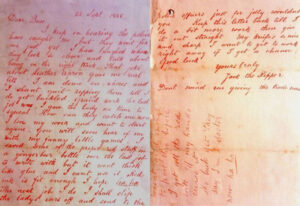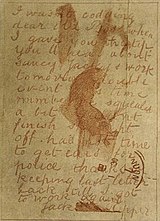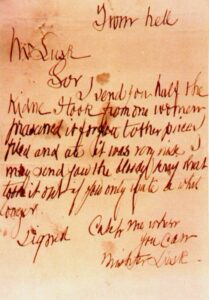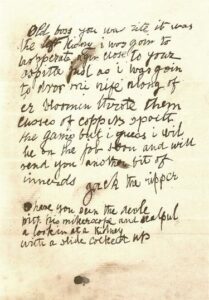DESCRIPTION OF CASE
From 1888 until 1891, eleven crimes were committed in Whitechapel, London, and six of them were considered to have many similarities that could be linked to the same killer. (Keppel, Weis, Brown, & Welch, 2005, p. 1).
All crimes supposedly committed by Jack consisted on killing white and poor women and most of them were prostitutes. His victims were the following: Emma Elizabeth Smith, Martha Tabram, Mary Ann Nichols, Annie Chapman, Elizabeth Stride, Catherine Eddowes, Mary Jane Kelly, Rose Mylett, Alice Mckenzie, Frances Coles and another body was found but the identity is unknown (Keppel, Weis, Brown & Welch, 2005, p. 3). What characterized those crimes was that they were committed in a very similar way by stabbing or strangling the victims and after analyzing the different murders, the similarities were examined with the aim of finding the killer.
According to Keppel, Weis, Brown and Welch, each killer has his/her modus operandi and signature characteristics. The first one refers to the “steps” or “rules” that the killer follows in order to carry out the crime. Signature characteristics are those behaviors that make the killer a unique figure with his/her own style when committing crimes. Now, taking into account the modus operandi, it was known that Jack killed his victims by stabbing them with a knife, strangling and cutting off parts of their bodies. Another point to highlight is the fact that these crimes were always committed between midnight and early morning, in nearby places and the victims were white and poor prostitutes as it has been mentioned before. Regarding signature characteristics, it is shown a kind of pattern followed by the killer such as the process of moving from stabbing to mutilating. It is also necessary to point out the fact that he shows superiority in the way in which he killed his victims because they seemed to be submissive. (Keppel, Weis, Brown, & Welch, 2005, p. 14-16).
DOCUMENTS EXAMINED IN THE CASES AND LINGUISTICS INVOLVED
DEAR BOSS LETTER:
This letter has two pages and it was written in red ink (which could refer to the blood of Jack’s victims) and it dated from 25 September 1888 (Whitechapel Jack, 2021). At first sight, it looks like an organized letter, with small letters and little separation between each line. Besides, he writes the words in italics which results in a clear organization in combination with the previous characteristics. There are also three underlined words: “right” (maybe in order to emphasize his idea that the police were wrong about their own assumptions), “red” (probably underlined because it refers to the blood of his victim), and “ha ha” (used to make it clear that he was mocking the police). With a brief analysis on the syntactic structure, it can be seen multiple uses of the personal pronoun “I” followed by infinitive verbs or verbs in their past form or some modal verbs. In fact, the author repeats many times “I do” in order to emphasize his next action or idea. Due to the use of these verbs and modal verbs, the structures written by the author are complex, using some coordinated and that- clauses. However, the author commits some grammatical mistakes because it seems like in some clauses there are missing words because the meanings are confusing. Furthermore, some other clauses need commas or dots. And as it is known, the nickname of this killer appears for the first time at the end of this letter.
In another research in which the Uruguayan mathematician Eduardo Cuitiño was involved, the signature taken from the Dear Boss letter was used to compare the letter “p” with that of the surgeon called Stephen Herbert Appelford. Appelford lived in a neighborhood which was close to the place where the crimes were committed and many doctors and surgeons worked in those zones. It was found that the handwriting of Appelford was similar to the “Dear Boss” letter (Cuitiño, 2015, p. 11). The point to highlight was that the surname of the surgeon and “ripper” both have double “p” and these “p” were overlapped in order to see if they coincided and it was the case. (Cuitiño, 2015, p. 15). Moreover, the letter “p” was not the only element analyzed and compared to Jack’s calligraphy in the “Dear Boss” letter, which was the main letter attributed to Jack. In fact, the census chart of the surgeon was also used in order to make comparisons with the handwriting of the “Dear Boss” letter. The first important thing to highlight in both writings is the slant of the letters which seem to be in italics. The slant is noticeable in the way the write the letter “s” because both letters coincide along with their form. Both the surgeon and the killer write the “f” with a long line that goes down and a “t” with the top mark very long to the right. The letter “m” also seems to be written the same by both people because of the first line and the last one and the aperture of it. Although some more letters are similar, it is also important to point out that both write the point of the “i” as if they were accents because of the upward line they draw.
Despite the similarities in the two writings, Appelford was just one more suspect of all surgeons or doctors who were related to Jack considering that the murderer could be a doctor or simply have knowledge of it.
SAUCY JACKY POSTCARD:
A few days later the “Saucy Jacky” postcard was sent to the police, dating from 1 October 1888 (Whitechapel Jack, 2021). The content of the postcard focuses on what was understood as the “double event” because the night before receiving the postcard, Jack killed two of his victims, Elizabeth and Catherine. If this postcard is compared to the previous one as Andrea Nini did, the words written by the author are bigger than the other words of the previous letter and some letters like the “y” are not the same. Besides, the postcard is not as well organized and clean as the “Dear Boss” letter. In fact, the clauses are too long and some commas are needed as well. There is little separation between lines but these are not straight. As the previous letter, the postcard is also signed at the end by Jack the Ripper.
Despite the similarities found in the written documents, the author or authors are still unknown.
FROM HELL LETTER:
The next important letter dated from October 16th 1888 and was addressed to Mr Lusk (who was the president of the Mile End Vigilance Committee) (Whitechapel Jack, 2021). This letter was in a box and accompanied by a kidney which it was thought that was from his victim Catherine Eddowes (Whitechapel Jack, 2021). Again, the killer seemed to be mocking the police because it is also said that maybe he was going to send Lusk the knife used to kill the victim. This letter is not as well organized as the first important letter when his name appeared for the first time. In this writing, it is noticeable that the killer keeps leaving little separation between lines and words are long and they are written in italics. Although the letter is short, there still are some grammatical mistakes like in “kidne” instead of “kidney” and then the word “knif” is also wrong written, instead of writing “knife”. There is also another mistake in “prasarved” instead of “preserved” and also it is written “wate” instead of “wait” and “whil” instead of “while”. There is another mistake at the end of the letter because the author writes “mishter” instead of “mister”. Furthermore, there isn’t any signature at the end, there is just the word “signed”. It is also necessary to add that the letter is composed by only two long subordinated clauses.
In order to make a better analysis of the letter, the criminologist Juan Francisco Alcaráz made his own research on this writing. He states that the aim of the letter was to challenge the police and the people of Whitechapel since no one could guess who was behind the murders. Moreover, Juan Alcaráz describes the type of text as informative but also as prescriptive (which could be considered as expositive text too) (Alcaráz, 2012, p. 48). In order to catch the attention of the readers, he uses his idea of the kidney and that he ate half of it. If the degree of information is taken into account as the criminologist did, the author contributes new information because he talks about something that he did to his victim. Also, the letter could be said to share the context of the others two letter and postcard since the three writings talk about crimes committed by the same author. In brief, the author has good calligraphy but some words are unstable and its ideas seems to be disorganized along with the grammatical mistakes that were not committed on purpose (Alcaráz, 2012, p. 52-53).
OPENSHAW LETTER:
The next letter related to Jack was the “Openshaw” letter which was sent to Dr. Openshaw (who was the doctor in charge of examining the kidney sent with the “From Hell” letter) on 29th October 1888. (Jones, 2021). From the content it is obvious that the letter is addressed to the doctor since the author is referring to the kidney of the previous letter. At first sight, the letter has two complex clauses but they are not separated by dots or commas and it is signed by the supposed Jack in the middle. The organization of the writing is messy and in some parts the ink has been moved, the separation between words is not very big and other words are crooked. If it is compared to the “From Hell” letter some grammatical mistakes can be seen such as the use of “kidny” instead of “kidney” (the author writes wrong the word “kidney” once and right the other time he uses it). Other letters are missing in words like “wil” instead of “will” or “agin” instead of “again”. There is another grammatical mistake in the word “operate” which has been written “hoperate” or the word “knife” which has been written “nife”. Regarding calligraphy when comparing it with the previous letter, it can be seen that the style of writing of the authors is not the same. In fact, this letter seems to have been written by a little kid because of the proper organization of the writing and the messy words.
The novelist Patricia Cornwell carried out her own investigation and she thought that the author of the letters or the proper Jack the Ripper could be Walker Sicker (Ryder, 2021). She made DNA tests on alleged letters written by Jack but the results were inconclusive.
NINI’S ANALYSIS:
Another linguist who was involved in the investigation of the letters during the last few years is Dr. Andrea Nini, specialized in forensic linguistics, who decided to carried out his own research about these documents based on comparisons and repetitions. Now, Nini’s analysis will be used to see the importance of this branch of linguistics in the Jack the Ripper’s case and how the considered most important letters attributed to Jack could be related.
The main aim of Nini’s paper is to make a comparison of the mentioned letters taking into account repetitions of some structures used in the writings. By doing this he tries to reach a conclusion as to the authorship attribution and to discover the possible connection between the chosen letters due to the fact that they could be written by the same author. In his analysis, he does not follow an order when analyzing the letters but he analyses them in pairs or groups. Nini makes use of the Appendix in which Skinner and Evans collected all the written documents that were attributed to Jack the Ripper.
To carry out the analysis, Nini uses the n-grams previously mentioned. More concretely, he focuses on 2-grams (which refers to combinations of two consecutive words within a structure like a sentence used in a written document) to measure the frequency of 2- grams used in the texts attributed to Jack. The idea of using the n-grams is also to detect plagiarism because if these combinations of words are repeated in some texts it would be possible that the authors of the texts were the same. (Nini, 2018, p. 625).
First, a comparison of the writings “Dear Boss” letter and “Saucy Jacky” postcard is made with some of the sentences used by the author. There are combinations of two words that are used in both writings although they do not have the same syntactic function. The examples used by Nini to explain this are the sentences [ till I do a bit more work] which belongs to the “Dear Boss” letter and another sentence which is [number one squealed a bit] that is taken from the postcard. In both writings the author writes “a bit” but in the first sentence it acts as a noun phrase while in the other sentence it is used as an adverbial phrase. Apart from this, there are also repetitions of other combinations of two words using the same verbs in the same structures, which could be considered as a proof that the author of both writings is the same. Other examples used by Nini are these two sentences [I gave the lady no time to squeal] which is taken from the letter and the other sentence [I gave you the tip] which is from the postcard. It can be seen that the structure used is the same with the repetition of the 2-grams (the subject and the verb). There is another interesting case of 2-grams and 4-grams in which one combination is repeated in the same letter and in the postcard as well. In the “Dear Boss” letter there are three sentences which are repeated: [till I do get buckled], another sentence which is [keep this letter back till I do] which is a combination of 4-grams and the first sentence that has been mentioned before [till I do a bit more work]. In the postcard appears the following sentence [till I got to work again] and another sentence which is [thanks for keeping last letter back till I got to work]. The fact that the structure “till I” is repeated so many times really means that there is a relation between both writings and the author could be the same. Besides, in the same sentences mentioned there is another repetition with the combination of “letter back”, being another proof about the similarities and frequencies of the structures found in the writings (Nini, 2018, p. 629).
It is also important to add that in both letter and postcard there are complex sentences with subordination and infinitive clauses like the ones mentioned above. By this use of the language the author is able to link the ideas well. Besides, Nini points out the following detail: “‘Dear Boss’ and ‘Saucy Jacky’ also share the use of the verb ‘work’ to euphemistically indicate the act of killing” (2018:629), therefore it is another proof of the relation between the letter and the postcard.
With the analysis of these writings, Nini confirms the possible relation between the writings due to the fact that there are many repetitions of structures and frequencies in the letters and postcard. However, Nini considers that the most likely relation is between the “Dear Boss” letter and the “Saucy Jacky” postcard because the “Midian” letter could be just a great copy of the style of the other writings (Nini, 2018, p. 633-634). Although there could be a relation between these letters, the authorship of any of them is not known.
The letters shown in this section are considered the most important of those attributed to Jack the Ripper due to the fact that in the “Dear Boss” letter the name “Jack the Ripper” appears for the first time, in the “Saucy Jacky” postcard the author mentions the “double event”, the “From Hell” letter was in a box with a kidney that could belong to the victim Catherine and the “Openshaw” letter could be related to the “From Hell” letter because it was sent to the Dr. Openshaw, who was in charge of examining the kidney. Moreover, these documents are really the ones that gave useful information to the police, whose contents make sense when they are related to the crimes.
CONCLUSION
Regarding calligraphy, in the analyses of these documents mostly differences could be seen between them, which made it difficult for researchers to find out the author behind those letters. However, Nini found a possible relation between the “Dear Boss” letter and the “Saucy Jacky” postcard due to the fact that they shared many n-grams which are repeated in both documents. Considering that the “Dear Boss” letter was the first letter in which appears the nickname of Jack the Ripper and that the “Saucy Jacky” postcard was also signed with that nickname in order to establish this idea of a possible link between them. Also, the postcard refers to the “double event” which could mean again that the author of the first letter and the postcard could be the same. The other link that I considered that could be possible was between the “From Hell” letter and the “Openshaw” letter mostly because the first one came with a kidney from the victim Catherine and the second one was sent to Dr. Openshaw who was the one analyzing the kidney.
In the case of Jack the Ripper, it should be noted that no linguist was able to find any real author. Even though the analysis of Cuitiño which was based on the idea that the double “p” found in “ripper” in the “Dear Boss” letter and in “Appelford” could be key to discover a possible author of such letter, there was not enough evidence to prove it.
THE LETTERS
 (Dear Boss letter)
(Dear Boss letter)
 (Saucy Jacky postcard)
(Saucy Jacky postcard)
 (From Hell letter)
(From Hell letter)
 (Openshaw letter)
(Openshaw letter)
BIBLIOGRAPHY
– Alcaráz, J. P. (2012). El Asesinato en serie: Los Mensajes Escritos. El Perfilador, 7. Pp. 40-58.
– Cuitiño, E. (2015). La Identidad de Jack el Destripador, Skopein: La Justicia en Manos de la Ciencia, 1, pp. 1-37.
– Jones, R (2021). Dr. Oppenshaw consulted on the kidney, accessed 13 June 2021, <https://www.jack-the-ripper.org/openshaw.htm>
– Keppel, R.D., Weis, J. G, Brown, K. M & Welch, K. (2005). The Jack the Ripper murders: a modus operandi and signature analysis of the 1888–1891 Whitechapel murders, Investigative Psychology and Offender Profiling, 2, pp. 1-21.
– Nini, A. (2018). An authorship analysis of the Jack the Ripper letters, Digital Scholarship in the Humanities, Vol. 33, 3, pp. 621-636.
– Ryder, S. P (2021). Patricia Cornwell and Walter Sickert: A Primer. Casebook: Jack the Ripper, <https://www.casebook.org/dissertations/dst-pamandsickert.html#>
– Whitechapel Jack (2021). The Ripper Letters, accessed 20 May 2021. <https://whitechapeljack.com/the-ripper-letters/>
Leave a Reply